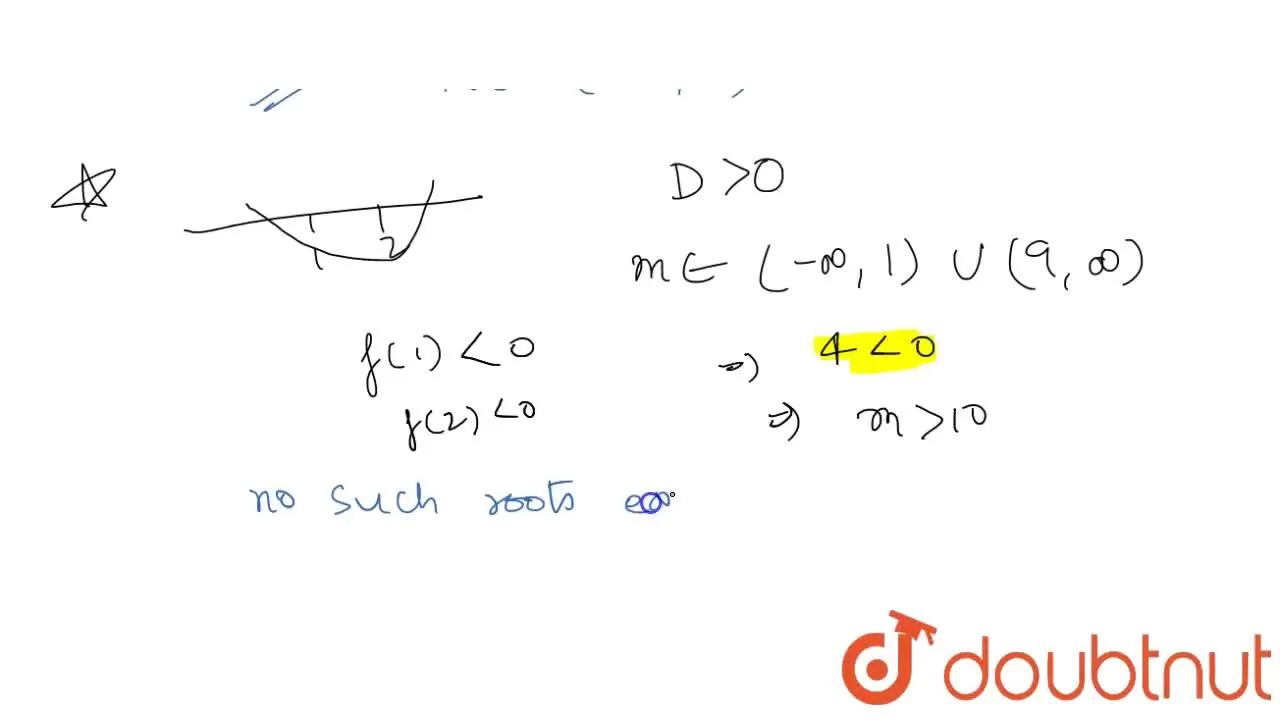Let x2−(m−3)x+m=0(mεR) be a quadratic equation . Find the values of m for which the roots are (ix)one root is smaller than 2 & other root is greater than 2 (x) both the roots are greater than 2 (xi) both the roots are smaller than 2 (xii)exactly one root lies in the interval (1,2) (xiii) both the roots lies in the interval (1,2) (xiv) atleast one root lies in the interval (1,2) (xv) one root is greater than 2 and the other root is smaller than 1
(x) one root is < 2 and other is > 2
From graph we get,
D≥0
m∈(-∞,1)∪[9,∞) (1)
a*f(2)=1*f(2)<0
4−(m−3)⋅2+m<0
m+4−2⋅m+6<0
m>10 (2)
take the intersection of interval (1)
Ans=m∈(10,∞)
Again from the graph
D≥0
m∈(-∞,1)∪[9,∞)
(1)
a⋅f(2)>0
f(2)=10−m>0
m<10
(2)
Now vertex
−b2⋅a≥2
m−3>4
take intersection of intervals (1) and (2)
Ans=m∈[9,10]
(xi)
boot root <2
from graph
1) D≥0
m∈(-∞,1)∪[9,∞) (1)
2)a⋅f(x)>2
⇒m<10 (2)
3)−b2a<2
m−33<2 (3)
take the intersection of inervals (1),(2),(3)
Ans=
m∈(−∞,1]
xii)
Exactly one root in interval (1,2)
D≥0
m∈(-∞,1)∪[9,∞) (1)
f(1)⋅f(2)<0
(1−m+3+m)⋅(4−2m+6+m)<0
4⋅(10−m)<0
m∈[10,∞)=Ans
xiii)
Boot roots Lies (1,2)
from posibilities by graph
D≥0
m∈(-∞,1)∪[9,∞) (1)
f(1)>0 and f(2)>0
4>0
1<−b2⋅a<2
1<m−22<2
2<(m−3)<4
5<m<7
now taking intersection from both the intervals
no such common intervals or no such m exist
xiv)
both the roots can not lie in the interval
⇒ 1 root lies ∈ (1,2)
D≥0
m∈(-∞,1)∪[9,∞) (1)
f(1)⋅f(2)<0
4⋅(10−m)<0
intersection
m∈(10,∞)
xv)
one root >2
or the root <1
D≥0
m∈(-∞,1)∪[9,∞) (1)
f(1)<0
f(2)<0
since,f(1)=4(+ive)
Ans=No such m exists.
Similar Questions
Let x2−(m−3)x+m=0(m∈ R) be a quadratic equation. Find the value of m for which the roots are
(i) real and distinct
(ii) equal
(iii) not real
(iv) oppsite in sing
(v) equal in magnitude but opposite in sing
(vi) positive
(vii) negative
(viii) such that at least one is positive
(ix) one root is smaller than 2 and the other root is greater then 2
(x) both the roots are grater then 2
(xi) both the roots are smaller then 2
(xii) exactly one root lies in the interval ( 1, 2)
(xiii) both the roots lie in the interval (1, 2)
(xvi) at least one root lies in the interval (1, 2)
(xv) one root is greater than 2 and the other root is smaller than 1View SolutionLet 4x2−4(α−2)x+α−2=0(α∈R) be a quadratic equation. Find the values of α for which
One root is smaller than 12 and other root is greater than 12View SolutionIf one root is greater then 3 and other root is less than 1 'a' belongs to
View SolutionLet 4x2−4(α−2)x+α−2=0(α∈R) be a quadratic equation. Find the values of α for which
Both the roots are smaller than 12View SolutionLet 4x2−4(α−2)x+α−2=0(α∈R) be a quadratic equation. Find the values of α for which
One root is greater than 12 and other is smaller than 0View SolutionLet 4x2−4(α−2)x+α−2=0(α∈R) be a quadratic equation. Find the values of α for which
Both the roots are greater than 12View SolutionLet x2−2(a−1)x+a−1=0(a∈R) be a quadratic equation, then find the value of 'a' for which
(a) Both the roots are positive
(b)Both the roots are negative
(c) Both the roots are opposite in sign.
(d) Both the roots are greater than 1.
(e)Both the roots are smaller than 1.
(f) One root is small than 1 and the other root is greater than 1.View SolutionFind the values of a for which one root of equation (a−5)x2−2ax+a−4=0 is smaller than 1 and the other greater than 2.
View SolutionLet x2−2(a−1)x+a−1=0(a∈R) be a quadratic equation, then find the values of "a" for which
(i) Exactly one root lies in (0,1)View SolutionDifferent condition for location of roots(vi) If α<k<β (vii)Exactly one root lying in the interval (k1,k2) (viii) Both the roots lying in the interval (k1,k2) (ix)One root is smaller than k1 and other roots is greater than k2
View Solution


